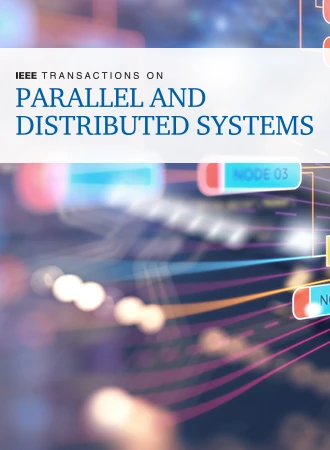在 6 G 云边缘协作计算中利用分布式深度强化学习实现主动缓存
IF 5.6
2区 计算机科学
Q1 COMPUTER SCIENCE, THEORY & METHODS
IEEE Transactions on Parallel and Distributed Systems
Pub Date : 2024-03-28
DOI:10.1109/TPDS.2024.3406027
引用次数: 0
摘要
在 6G 云边协作场景中主动缓存,智能地定期更新缓存内容,既能缓解回程链路和边缘协作链路的流量拥塞,又能为移动用户带来多媒体服务。为了进一步提高 6G 云边缘的网络性能,我们考虑了多目标联合优化问题,即在最大化边缘命中率的同时,最小化内容访问延迟和流量成本。为解决这一复杂问题,我们重点研究了基于分布式深度强化学习(DRL)的主动缓存方法,包括内容预测和内容决策。具体来说,由于用户请求的先验信息在当前时间段很少能实际获得,因此我们采用了一种基于时空卷积网络(TCN)和注意力模型的名为时空卷积序列网络(TCSN)的新方法来提高内容预测的准确性。此外,根据内容预测的价值,分布式深度 Q 网络(DDQN)寻求建立回报分布模型,以优化内容决策策略。生成式对抗网络(GAN)以分布式方式进行调整,强调学习数据分布,并在多个节点上生成引人注目的数据。此外,优先经验重放(PER)有助于从最有效的样本中学习。因此,我们提出了一种名为 PG-DDQN 的多元融合算法。最后,面对如此复杂的场景,我们采用分布式学习架构,即多代理学习架构,以集中训练和分布式推理的方式有效地学习基于 DRL 的方法。实验证明,我们的建议在边缘命中率、流量成本和内容访问延迟方面都取得了令人满意的性能。本文章由计算机程序翻译,如有差异,请以英文原文为准。
Proactive Caching With Distributed Deep Reinforcement Learning in 6G Cloud-Edge Collaboration Computing
Proactive caching in 6G cloud-edge collaboration scenarios, intelligently and periodically updating the cached contents, can either alleviate the traffic congestion of backhaul link and edge cooperative link or bring multimedia services to mobile users. To further improve the network performance of 6G cloud-edge, we consider the issue of multi-objective joint optimization, i.e., maximizing edge hit ratio while minimizing content access latency and traffic cost. To solve this complex problem, we focus on the distributed deep reinforcement learning (DRL)-based method for proactive caching, including content prediction and content decision-making. Specifically, since the prior information of user requests is seldom available practically in the current time period, a novel method named temporal convolution sequence network (TCSN) based on the temporal convolution network (TCN) and attention model is used to improve the accuracy of content prediction. Furthermore, according to the value of content prediction, the distributional deep Q network (DDQN) seeks to build a distribution model on returns to optimize the policy of content decision-making. The generative adversarial network (GAN) is adapted in a distributed fashion, emphasizing learning the data distribution and generating compelling data across multiple nodes. In addition, the prioritized experience replay (PER) is helpful to learn from the most
effective
sample. So we propose a multivariate fusion algorithm called PG-DDQN. Finally, faced with such a complex scenario, a distributed learning architecture, i.e., multi-agent learning architecture is efficiently used to learn DRL-based methods in a manner of centralized training and distributed inference. The experiments prove that our proposal achieves satisfactory performance in terms of edge hit ratio, traffic cost and content access latency.
求助全文
通过发布文献求助,成功后即可免费获取论文全文。
去求助
来源期刊

IEEE Transactions on Parallel and Distributed Systems
工程技术-工程:电子与电气
CiteScore
11.00
自引率
9.40%
发文量
281
审稿时长
5.6 months
期刊介绍:
IEEE Transactions on Parallel and Distributed Systems (TPDS) is published monthly. It publishes a range of papers, comments on previously published papers, and survey articles that deal with the parallel and distributed systems research areas of current importance to our readers. Particular areas of interest include, but are not limited to:
a) Parallel and distributed algorithms, focusing on topics such as: models of computation; numerical, combinatorial, and data-intensive parallel algorithms, scalability of algorithms and data structures for parallel and distributed systems, communication and synchronization protocols, network algorithms, scheduling, and load balancing.
b) Applications of parallel and distributed computing, including computational and data-enabled science and engineering, big data applications, parallel crowd sourcing, large-scale social network analysis, management of big data, cloud and grid computing, scientific and biomedical applications, mobile computing, and cyber-physical systems.
c) Parallel and distributed architectures, including architectures for instruction-level and thread-level parallelism; design, analysis, implementation, fault resilience and performance measurements of multiple-processor systems; multicore processors, heterogeneous many-core systems; petascale and exascale systems designs; novel big data architectures; special purpose architectures, including graphics processors, signal processors, network processors, media accelerators, and other special purpose processors and accelerators; impact of technology on architecture; network and interconnect architectures; parallel I/O and storage systems; architecture of the memory hierarchy; power-efficient and green computing architectures; dependable architectures; and performance modeling and evaluation.
d) Parallel and distributed software, including parallel and multicore programming languages and compilers, runtime systems, operating systems, Internet computing and web services, resource management including green computing, middleware for grids, clouds, and data centers, libraries, performance modeling and evaluation, parallel programming paradigms, and programming environments and tools.
 求助内容:
求助内容: 应助结果提醒方式:
应助结果提醒方式:


